![]()
![]()
![]()
Use LEFT and RIGHT arrow keys to navigate between flashcards;
Use UP and DOWN arrow keys to flip the card;
H to show hint;
A reads text to speech;
101 Cards in this Set
- Front
- Back
- 3rd side (hint)
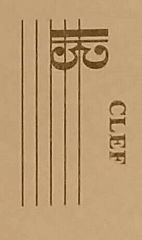
Ch.1 |
Soprano |
|
|
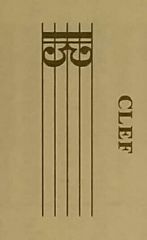
Ch.1 |
Mezzo-soprano |
|
|

Ch.1 |
Alto |
|
|
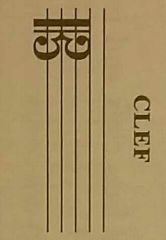
Ch.1 |
Tenor |
|
|
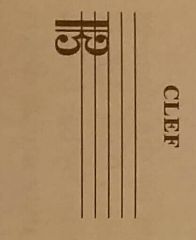
Ch.1 |
Baritone |
|
|
|
Ch.1:Where do stem flags go if: • on mid C on staff • Treble Clef |
To the right and up |
|
|
|
Ch.1:How do you determine where C is using a C-Clef |
By the line in between the middle loops of Clef |
|
|
|
Ch.1:What is Timbre |
Color of sounds |
Different sounds between same note played on flute & oboe |
|
|
Ch.1:No flats or sharps in Key sig |
Key of C |
|
|
|
Ch.1:Key of : 1 flat |
Key of F |
|
|
|
Ch.1:Key of : 2 flats |
Key of Bb |
|
|
|
Ch.1:Key of : 3 flats |
Key of Eb |
|
|
|
Ch.1:Key of : 4 flats |
Ab |
|
|
|
Ch 1:Key of : 5 flats |
Db |
|
|
|
Ch.1:Key of : 6 flats |
Gb |
|
|
|
Ch.1: Key of 1 # |
G |
|
|
|
Ch.1: Key of 2 # |
D |
|
|
|
Ch.1: Key of 3# |
A |
|
|
|
Ch.1: Key of 4# |
E |
|
|
|
Ch.1: Key of 5 # |
B |
|
|
|
Ch.1: Key of 6 # |
F# |
|
|
|
Ch.2: time signature meter? 4/16 4/8 4/4 4/2 |
Simple quadruple |
|
|
|
Ch.2: time signature meter? 2/16 2/8 2/4 2/2 |
Simple duple |
|
|
|
Ch 2: time signature meter? 3/16 3/8 3/4 3/2 |
Simple triple |
|
|
|
Ch.2: time signature meter? 6/16 6/8 6/4 6/2 |
Compound duple |
|
|
|
Ch.2: time signature meter? 9/16 9/8 9/4 9/2 |
Compound triple |
|
|
|
Ch.2: time signature meter? 12/16 12/8 12/4 12/2 |
Compound quadruple |
|
|
|
Ch.2: Hemiola |
Special type of syncopation in triple meters, in which the beat is temporarily regrouped into twos. |
|
|
|
Ch.2: Syncopation |
Occurs when the emphasis or stress is in between the beats or in a normally weak beat |
|
|
|
Ch.3: Major scale pattern |
W-W-H-W-W-W-H |
|
|
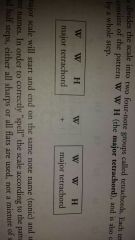
Ch.3: |
(Just reminder) |
|
|
|
Ch.3: Natural (pure) minor scale pattern |
W-H-W-W-H-W-W ■ for a parallel minor scale, Ex: A major 》A minor •Flat 3rd, 6th, 7th A major : A B C# D E F# G# A A minor : A B C D E F G A |
|
|
|
Ch.3: Relative minor of C |
A |
|
|
|
Ch.3: Relative minor of G |
R |
|
|
|
Ch.3: Relative minor of D |
B |
|
|
|
Ch.3: Relative minor of A |
F# |
|
|
|
Ch.3: Relative minor of E |
C# |
|
|
|
Ch.3: Relative minor of B |
G# |
|
|
|
Ch.3: Relative minor of Gb |
Eb |
|
|
|
Ch.3 Relative minor of Db |
Bb |
|
|
|
Ch.3: Relative minor of Ab |
F |
|
|
|
Ch.3: Relative minor of Eb |
C |
|
|
|
Ch.3: Relative minor of Bb |
G |
|
|
|
Ch.3: Relative minor of F |
D |
|
|
|
Ch4 |
Solfege |
|
|
|
Ch 4 Moveable __ |
Moveable do |
|
|
|
Ch 4. Other base of solfege |
La based |
|
|
|
Ch 4 ... top ten melodic patterns |
Mi re do |
|
|
|
Ch 4 top ten. Melodic patterns |
Re ti do |
|
|
|
Ch.5 : Augmented symbol |
+ or A |
|
|
|
Ch.5 Diminished symbol |
○ |
|
|
|
Ch. 5 : to find hard intervals |
Transpose to a different easier key first, then transpose back to other key |
|
|
|
Ch.5 : A4 and Dim5 are example of enharmonics |
-.- |
|
|
|
Ch.5 : Rule of 9 |
When any simple interval is inverted, the sum of the ascending and descending intervals must add up to 9 |
|
|
|
Ch. 6 : In harmonic minor, which scale degree is raised |
7th |
|
|
|
Ch. 6 : 1st inversion of triad |
6/3 = 3rd in base |
|
|
|
Ch. 6 : 2nd inversion for triad |
6/4 = 5th in base |
|
|
|
Ch. 6 : root position 7th chord |
7 = root position |
|
|
|
Ch. 6 : 1st inversion of 7th chord |
6/5 = 3rd in base |
|
|
|
Ch. 6 : 2nd inversion of 7th chord |
6/4 = 5th in base |
|
|
|
Ch. 6 : 3rd inversion of 7th chord |
4/2 = 7th degree in base |
|
|
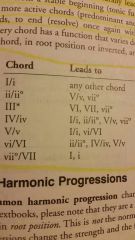
Ch. 9 |
. |
|
|
|
Ch. 9 : Circle Progression : ___ |
Is the movement of chords where the root (not necessarily the bass) of each chord is a diatonic fifth above the next chord. |
|
|
|
Ch. 9 : Tonic chords : destination chords |
( I , i, vi, VI ) are often destination chords especially when in root position. |
|
|
|
Ch. 9 : Dominant Function , chords |
( V, vii ) Dominant Function chords move the harmony forward ; they provide an active energy when inverted |
|
|
|
Ch. 9 : Subdominant Function chords |
( IV, ii ) are transition chords, connecting tonic to dominants; that's why they are considered predominant |
|
|
|
Ch. 10: a Double period |
Is a group of 4 phrases in which only PAC at the conclusion of a 4th phrase. |
|
|
|
Ch. 10: Most important part of a composition ? |
Melody : a progression of rhythms and pitches |
|
|
|
Ch. 10: expansion |
Adds new material typically to the end of the original phrase |
|
|
|
Ch. 10: Modulation |
Repeats the same motif exactly but in a different way usually closely related to the original |
|
|
|
Ch. 10: Mode Mixture |
involves combining cords from the parallel major or minor mode to increase harmonic resources |
|
|
|
Ch. 6 : > superscript for minor chords > superscript for major chords |
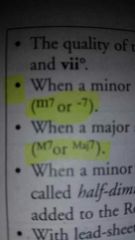
|
|
|

Ch. 6 |
Because the added seventh is raised, it makes a fully diminished chord half diminished |
|
|
|
Ch. 6 : first inversion of triad |
6 |
|
|
|
Ch. 6 : Second inversion of triad |
6/4 |
|
|
|
Ch. 13 : Most unstable (active) scale degrees |
7... then 4 |
|
|
|
Ch. 13 : most stable Scale degrees |
1... then 3 |
|
|
|
Ch. 13 : Temporary Tonicization |
Is generally attributed to the borrowing two or three chords from a closet related key to heighten the harmonic intensity and color. |
|
|
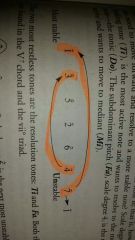
Ch. 13 |
. |
|
|

Ch. 13 |
. |
|
|
|
Ch. 12: Mode Mixture |
Is the harmonic technique of combining chords from a major key and the parallel minor, or mixing the parallel major and minor mode using the b3, b6 & b7 from the parallel natural minor |
|
|
|
Ch. 12: Picardy 3rd |
one of the most common uses of mode mixture when in minor is the practice of ending a piece with an authentic cadence using a major tonic. The major is borrowed from the parallel for a more "authentic-sounding" ending. The third of the chord is raised to make it Maj. |
|
|
|
Ch. 12: Modulation |
Is the process of moving from one total Center to another, with or without changing the key signature |
|
|
|
Ch. 12: temporary Tonicization |
The significant difference between modulation and the temporary tonic ization, or simply passing through a region or area of a new key, is the occurrence of a convincing cadence and significant time in the new key. |
|
|
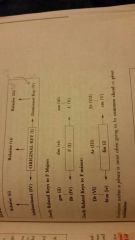
Ch. 12: |
Closely related keys |
|
|
|
Ch.14 : leading tone must... |
Resolve |
|
|
|
Ch.14 : fa resolves to |
Mi |
|
|
|
Ch.14 : P5 to dim5 is |
Acceptable |
|
|
|
Ch. 14 : dim5 to P5 is |
Not acceptable in common-practice style |
|
|
|
Ch. 14 : double the ___ in 6/4 chords |
5th |
|
|
|
Ch. 14 : Do not double the __ |
Leading tone (7) |
|
|
|
Ch. 16 :solo |
A single performer |
|
|
|
Ch. 16: soli |
Passage done by section |
|
|
|
Ch. 16: fugue |
Form of composition popular in the baroque era, in which a theme or subject is introduced by one voice and is limited by other voices in succession |
|
|
|
Ch.16 : polyphonic |
Also known as counterpoint. |
|
|
|
Ch. 16 : ostinato |
Meaning obstinate or unceasing, an ostinato is a short melodic, rhythmic, or harmonic pattern that is repeated throughout an entire composition or some portion |
|
|
|
Ch. 17: textural elements |
Monophonic Homophonic Melody with accompaniment Polyphonic Hetero phonic |
|
|
|
Ch. 17: Rhythmic |
Aural and visual identification |
|
|
|
Ch. 17 : meter |
Simple / compound - duple, triple, quadruple. Mixed meter, asymmetrical, symmetrical |
|
|
|
Ch. 17 : Harmony |
Triads 7th chords Inversions Secondary or chromatic Cadences Harmonic function. Harmonic progression Roman numerals analysis Mudulation |
|
|
|
Ch. 17: performance considerations |
Tempo, articulation, dynamics, style, ornamentation |
|

